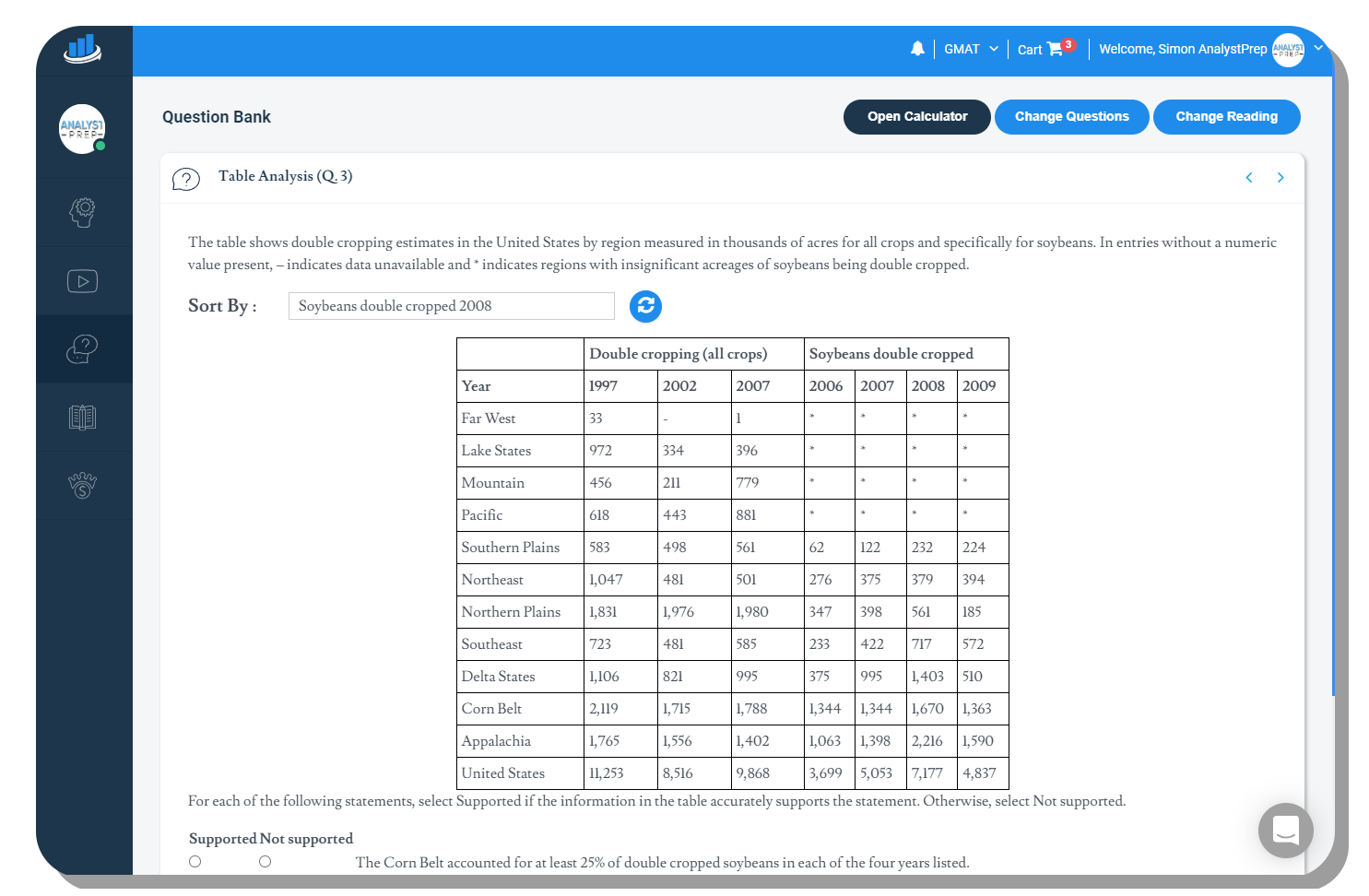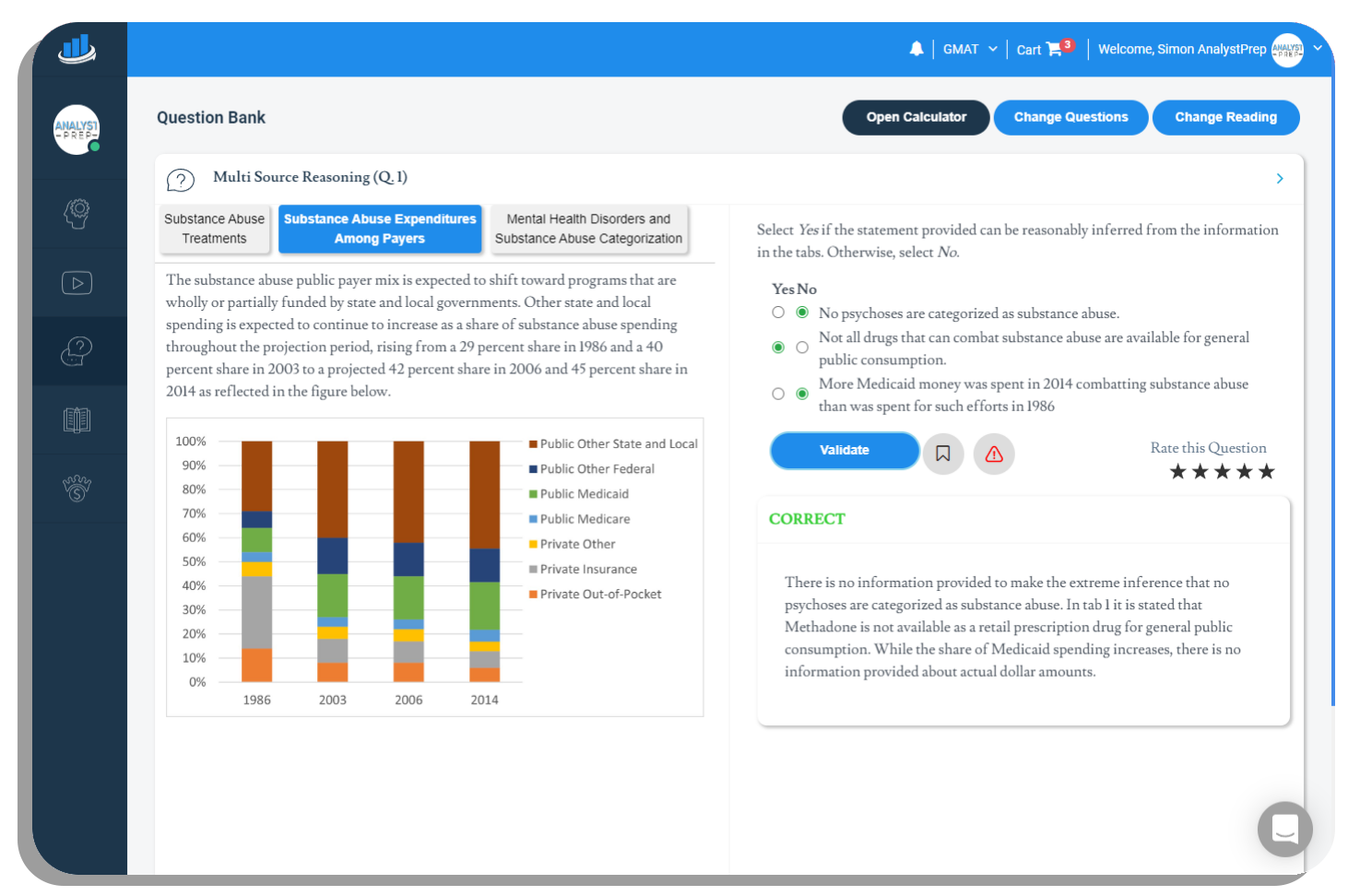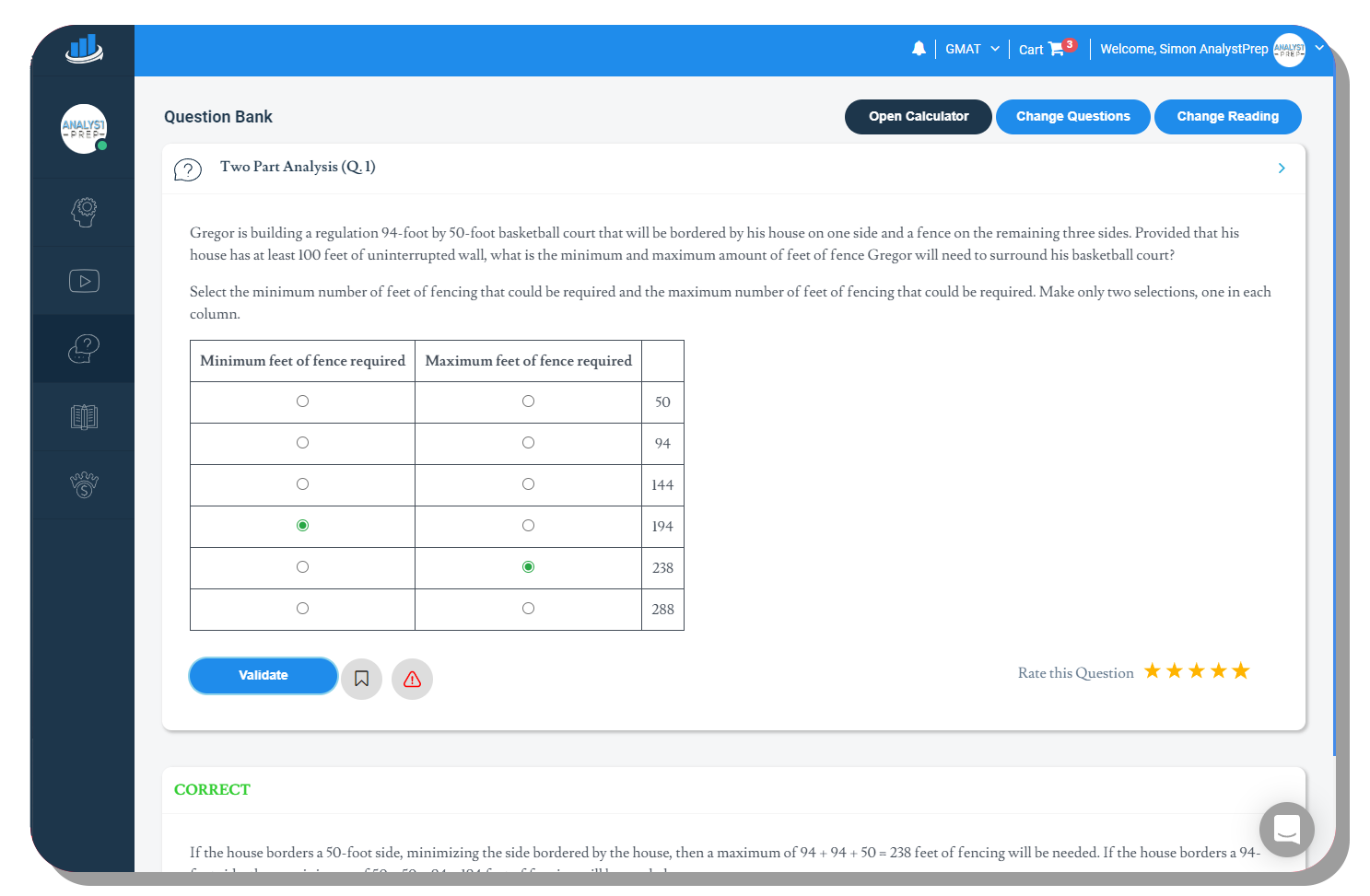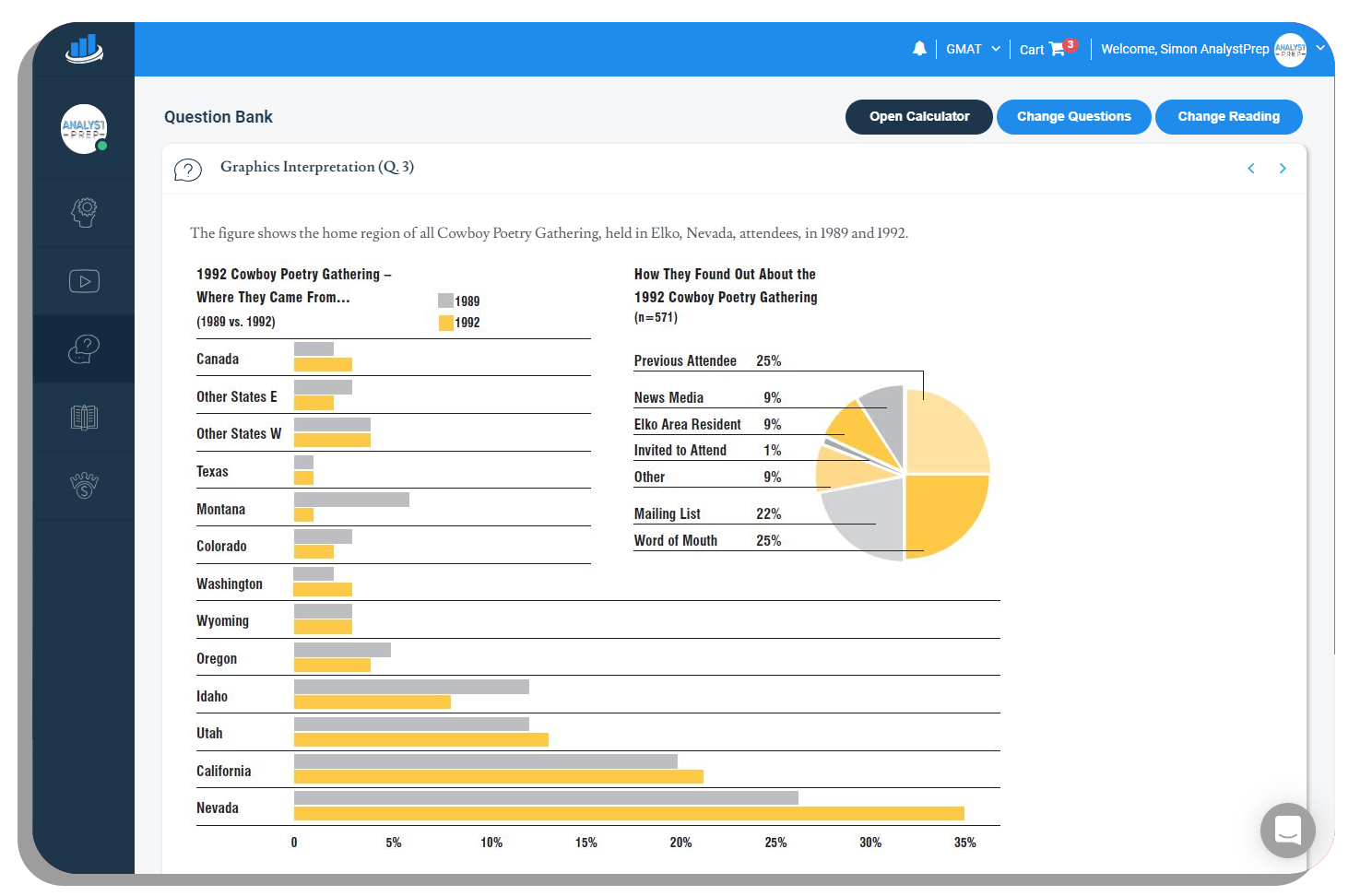EA® Integrated Reasoning Questions
Table Analysis
Multi-Source Reasoning
Two-Part Analysis
Graphics Interpretation

Types of Questions to Expect in the EA Integrated Reasoning Section
A Look at AnalystPrep's Preparation Platform for Integrated Reasoning Questions


What to Expect in the Integrated Reasoning Section of the Executive Assessment?
You will have 12 questions to complete in 30 minutes. Your first half target will be 12 minutes with a 15-minute maximum time allowed. This means you are going to spend 2-2.5 minutes on average per question. Remember, it is possible to miss up to two questions and still get a 10+ score on the Integrated Reasoning section. So if possible, look for opportunities to guess, but do so strategically.
The second half should take 15-18 minutes in total. Each question should take 2-3 minutes on average. Work through the full half completing your easier questions first. So if you see a question you are not ready to answer, just guess, skip, and return to it at the end.
Here’s what’s required of you in the integrated reasoning section of the EA:
- Synthesize and analyze data presented in texts, numbers, or graphics
- Evaluate relevant data from different sources
- Analyze and manipulate data to solve complex problems relying on information from multiple sources
- Organize data presented in tables to figure out relationships and solve multiple, interrelated problems
How Scores are Reported in the Integrated Section of the EA
Scores in the integrated reasoning section range between 0 and 20 in 1-point intervals. Some questions in the Integrated Reasoning section may consist of multiple subquestions. To score full credit for these types of questions, you must answer all the subquestions correctly. It’s worth noting that no partial credit will be awarded for these types of questions if you give a wrong answer to any of the subquestions.
Table Analysis
In this section, you’ll be given a sortable table of data similar to a spreadsheet, which you’re required to analyze and determine whether the answer statements are correct based on the information provided. Table analysis combines two skills – making logical deductions and breaking down tabular data.
The main challenge you’ll face when handling table analysis questions is facing a new set of data and figuring out how to fit all those pieces together. Table analysis is meant to determine your skills in solving real-world problems. Since you’ve already dealt with plenty of spreadsheets in your life, it shouldn’t be challenging to interpret this sort of data.
Multi-Source Reasoning
Multi-source reasoning offers three pieces of information on tabbed pages – data, tables, articles, emails, etc. While these pieces provide lots of information, not all of it is necessary to answer the question. The information provided may be quantitative or verbal in nature, or sometimes a combination of both. While working on these three pieces of information you may be required to click back and forth between them and locate the needed data.
The questions consist of either a set of yes/no statements or multiple-choice questions. You’ll need information from multiple tabs to answer the questions. However, you can use the same tab to answer more than one question. The questions in this category are designed to mimic the case study approach used by most management programs, therefore, examining one’s ability to put together different types of information from different sources.
Two-Part Analysis
In two-part analysis, you’ll be given a task that involves two components. It’s worth noting that each question is more than one question and based on the passage provided, you’ll be asked to evaluate two things – they could be definitions of two terms or two completely separate issues. Solving this kind of question isn’t usually complicated. However, it requires more work as you’re required to answer more than one question. Answers in two-part analysis can take multiple forms. You might be asked to fill in a black using a pull-down menu that provides multiple choices or answer a traditional multiple-choice question. Moreover, you may be required to select certain options in a table or give answers to two statements in the form of yes/no or true/false.
It’s worth noting that sometimes the two sections of a two-part analysis question may depend on each other or may be determined independently. Whichever the case, you only get credit if both halves are answered correctly.
Graphics Interpretation
Graphics representation questions require you to interpret a graph or graphical image in order to select the correct response from the choices provided based on the information you get from the graphs. These types of questions will always contain a graph and are designed to test your ability to analyze and interpret the information presented therein. In most cases, you’ll come across traditional graphs such as pie charts or bar graphs. However, in some cases, you may also see more unusual graphs, which shouldn’t be a cause for concern as the questions are answered the same way as those for traditional graphics.
The types of graphs you’ll come across include:
- Bar graphs
- Line graphs
- Flow charts
- Organization charts
- Venn diagrams
- Scatter plots
It’s advisable to read the introductory text before examining the graph. At the start, don’t try to analyze the graph. Instead, take a few moments to know how the graph works and the kind of information it represents. Since Graphics interpretation questions are usually less dense compared to other types of questions in the Integrated Reasoning section, you should spend less time here.
How Many Hours Should You Devote?
In order to be prepared for the exams, students should begin studying at least three to six months in advance. It is recommended that 120-150 hours of preparation be devoted in order to achieve an overall score of 150 or higher on the EA exam. Based on these 120-150 hours, you should spend approximately 30 hours or more learning about the questions you will encounter in the integrated reasoning section using real-exam scenarios.
Benefit of Study Materials Provided by Exam Preparation Platforms
You may find that studying alone can be quite daunting, especially if you are planning on taking your EA exam within a specific timeframe. In addition to giving you the sense of structure you need in order to structure your studying, taking an EA prep course will also help you maintain the discipline you need in order to study efficiently. As opposed to sitting down every day to decide what you’re going to study, you can take an Executive Assessment prep course such as AnalystPrep and have all the study content divided up into modules that you can easily work through.
With plenty of study resources at your fingertips, including video lessons, study notes, and practice questions, you are sure to be equipped with the right skills and knowledge to pass your EA exam with flying colors. You have the opportunity to study under real exam conditions by taking prep courses that are prepared based on current exam trends and levels of difficulty, as most prep courses are prepared based on current exam trends and levels of difficulty. It is very likely that you will discover specific tips and tricks that you have never heard of before that may help you improve your guessing accuracy, timing on exams, and overall efficiency.
FAQs About the Integrated Reasoning Section of the EA Exam
| What’s the time allocation for questions in the Integrated Reasoning section? | You’re given 30 minutes to solve the 12 questions of the Integrated Reasoning section covering the four question types: Multi-Source Reasoning, Graphics Interpretation, Table Analysis, and Two-Part Analysis. |
| Can I go back and change the answer after I’ve answered a question? | Unfortunately, once you submit an answer, you can’t go back and change it. That’s why it’s very essential to be sure of your answer before submitting it. |
| Do I need a calculator for the exam? | The Integrated Reasoning section of the EA exam is not meant to test your quantitative skills. An online calculator with basic functions is available, so remember to use it! |
| Do you get partial credit if you get one part of a single question correct? | Unfortunately, you get a credit only when you answer all the parts of a single question correct. No partial credit is given for questions in the EA Integrated Reasoning section. |

Compare Yourself to Other Candidates
AnalystPrep’s Preparation Platform includes an advanced built-in analytics software that allows you to keep track of your progress by monitoring your performance and comparing it to a class average. View your stats easily in attractive charts and quickly identify your strengths and weaknesses. Then, adapt your study method and improve your strategy in the areas that need more attention. Finally, compare your results with thousands of candidates who join AnalystPrep’s Prep Platform each year and stay motivated in your study sessions.

Questions Answered by our Users
Satisfied Customers
preparation platform according to review websites
EA® Prep Packages
You can combine both tools with the Learn + Practice Package for $249.
EA Practice Package
$
149
/ 12-month access
- Quantitative Practice Problems
- Verbal Practice Problems
- Integrated Reasoning Practice Problems
- Customizable Quizzes
- Performance Tracking Tools
EA Learn + Practice Package
$
249
/ 12-month access
- Conceptual Video Lessons
- Quantitative Practice Problems
- Verbal Practice Problems
- Integrated Reasoning Practice Problems
- Customizable Quizzes
- Performance Tracking Tools
EA Learn Package
$
149
/ 12-month access
- Conceptual Video Lessons








